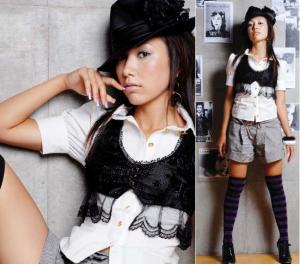The Rising Tides of Fashion Populism
By W David Marx (MEKAS)
 Young Japanese women are increasingly buying their clothes from domestic manufacturers -- Photography by Hiromi Iguchi
Young Japanese women are increasingly buying their clothes from domestic manufacturers -- Photography by Hiromi Iguchi
The overwhelming percentage of Japanese women owning Louis Vuitton handbags—anywhere between 30% and 90%, depending on whom you ask—has transcended objective statistical measure and transformed into a powerful symbol for the insatiable Japanese lust for European fashion goods and luxury brands. The numerous LV, Gucci, and Goyard handbags currently populating the Tokyo streets seem to suggest that nothing has changed in recent years. Few, however, are giving much attention to the nature of the clothing on the women carrying those luxury handbags.
Female Japanese consumers may still buy single bags from a European superbrand, but they have come to predominantly choose their core apparel items from cheaper domestic labels. Young women can afford a timeless, durable bag— neutral enough in style for daily usage— but can rarely partake in entire ensembles constructed from high-fashion houses. Economic conditions are mainly to blame: over fifteen years of a sluggish economy have made overindulgence in luxury fashion practically impossible for most middle class consumers. What is interesting, however, is that young women are not sour about limited budgets for high-end apparel, but have instead embraced a populist ideology demanding ‘Real Clothes’ that suit both their tastes and spending levels.
Real Clothes
The key term for this consumer movement is Real Clothes—a clever categorical name for affordable domestic brands like Moussy, Cecil McBee, and Apuweiser-Riche sold at shopping complexes Shibuya 109, Marui, and Printemps Ginza. Although the promoters of Real Clothes do not specifically claim that high-fashion is unreal or fake, this nuance is implied. Real Clothes do not indulge in artistic excess, design extremes, nor designer idiosyncrasies. The clothing tends to exist at an equal conceptual level as the consumer, due in part to the designers and customers’ shared demographic profile. Items are accessible, affordable, and intentionally devoid of any aspect which may lead to criticism from peers or society at large. The lack of challenge and attempts to change tastes, however, is exactly why consumers have shown such excitement.
Tokyo Girls Collection (TGC; see J@pan Inc Issue 73)—a huge young women’s fashion event thrown by eretailer Xavel.com—has been a key focal point for the Real Clothes boom. At TGC, fashion brands hold ‘collection shows’—borrowing the general style of fashion exhibition from more sophisticated haute couture lines, but tweaking the entire fashion show paradigm to fit with the populist spirit of these Real Clothes brands. Instead of severe faces from impossibly long-legged foreign models, smiling Japanese and half-Japanese women from the pages of CanCam, JJ, ViVi, and Glamorous prance upon the stage and wave to their fans. Much attention has been paid to the ability of female consumers to buy the outfits—exactly as styled on the runway—with their cellular phones, but this is just the functional expression of a larger trend: young consumers want things that they already understand and know and do not want to feel pressured, intimidated or made to feel inadequately cool. TGC succeeds not because it offers something on a higher style hierarchy than the girls in attendance, but because they are all made to feel like equals with the stars on the stage.
That consumers prefer products perfectly targeted to them should not come as a surprise, but in the past, Japanese fashion consumers often directly followed the advice of the mainstream media and charismatic brands without much consideration of their own values and tastes. There are many stories from the 1980s of 14-year old kids awkwardly and uncomfortably walking around in head-to-toe avant garde Comme des Garçons ensembles out of social obligation. The TGC/Real Clothes movement completely rejects this prior top-down model and realigns fashion standards somewhere between producer and consumer.
Consumers want their models and heroes to be as similar as possible to themselves
The magazine CanCam—which best represents the Real Clothes aesthetic— has been one of the only fashion magazines in Japan to buck the trends of imploding readership. Although the recent launch of ‘big sister’ title AneCan has somewhat eaten into CanCam’s sales, the magazine still has more readers than the competition because of its core demographic of college students and young office ladies (Ols). The key has been model Yuri Ebihara (aka Ebichan), who works almost exclusively for CanCam and has become the de facto face of the magazine and its associated style. Ebihara’s ‘cuteness’—rather than classic beauty—creates a sense of community and commonality with young women. Readers see Ebihara as a perfect expression of their preferred aesthetic, but they also see themselves in her face. Opposed to the almost universal usage of foreign and half- Japanese models in other fashion titles— from high-fashion Ginza to street fashion Spring—CanCam’s choice of using purely Japanese models appears quite intentional. Like with the clothing styles and the price ranges, Japanese consumers want their models and heroes to be as similar as possible to themselves.
Why populism now?
Why has the fashion populism implied in the Real Clothes boom blossomed in these first few years of the 21st century? First we must recognize that Japanese consumers gained a new confidence in their own culture by the end of the bubble era in the early 1990s. After years of dutifully chasing American and European style standards out of a national inferiority complex, the then-wealthy Japanese people realized that they had worked so hard at catch-up that they had finally outdone their international contemporaries. Meanwhile, fashion styles like the Kogal/Kogyaru (think fake tan, bright color Shibuya blondes) grew out of local subcultures rooted in Tokyo rather than based on influences from overseas or dictated from an elitist media complex. When the girls from the mass Kogal movement graduated into more reasonable and socially acceptable outfits, they turned to CanCam and JJ and brought their slightly-nationalistic spirit of ‘Japan First’ into the fashion world.
 Yuri Ebihara: a staple feature of CanCam magazine’s front cover
Yuri Ebihara: a staple feature of CanCam magazine’s front cover
Economics have also played a large role. As consumer budgets spiraled downward throughout the 1990s, trends started to grind to a halt as consumers could no longer keep up with incremental and artificial style changes. Real Clothes is not just a rejection of bowing down to the global fashion cabal, but a cry for stability and affordability. Trench coats and sweater dresses—recent favorites in the genre— are ‘in’ this year, but they’re so timeless that they may as well be ‘in’ every year. Colored tights may not have a life longer than this autumn, but they are a cheap investment regardless.
Furthermore, the rise of social disparity has had a huge impact on young women’s wardrobes. Over the last five years, consumer markets have become more oriented towards the explicit display of wealth. Instead of creating distinctions by asserting good taste, the New Rich in Japan have been happy to simply buy Ferrais, Armani suits, and jewel-encrusted watches. This may filter down to mass consumers as the need for luxury handbags with widely-known logos. More importantly, however, the number of men guaranteed to progress into upper middleclass wages is rapidly shrinking, thus making the quest for a ‘suitable’ husband much more challenging. CanCam’s success has been in branding its clothing as mote-kei—a style specifically geared to attract the opposite sex. The conventional wisdom now contends that well-to-do Japanese men abhor high-fashion and sub-cultural looks and want their potential wives in conservative Real Clothes.
 Japanese shoppers have a new confidence in their culture -- Photography by Hiromi Iguchi
Japanese shoppers have a new confidence in their culture -- Photography by Hiromi Iguchi
Conclusion
Real Clothes may be born from structural influences and socioeconomic pressures, but consumers have accepted the populist ethic at the base of the look at an ideological level. This psychological change has enormous implications for marketing in Japan, especially for international companies who have assumed in the past that they can simply wow potential customers through mere ‘foreignness’ or a coordinated media assault from above. Young customers are putting more and more pressure on firms to lower the bar to their level and make everything ‘real.’ And in this case, ‘real’ means ‘Japanese.’JI
W David Marx is a Planner at Tokyo-based advertising agency Diamond Agency and Chief Editor of MEKAS (www.mekas.jp), an Englishlanguage, member-exclusive website covering the Japanese fashion market. Marx writes the blog clast (www.clast.diamondagency.jp/en) for Diamond Agency, which is currently syndicated in Japanese on Livedoor News.
J@pan Inc Magazine, Nov/Dec 2007





